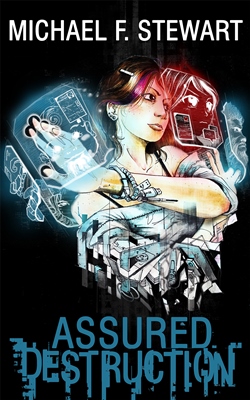I’ve enjoyed Ed’s writing ever since I listened to New World Order. I’m not ordinarily into political thrillers, but I dig these. Today I want to bring the thriller novel “Alive From America,” book two in the Terrorist Chronicles series to your attention. Then we’ll get into the questions.

Forget bin Laden and Sadaam. Forget the Taliban and al Qaida. The real battle against terrorism is in the shadows, fought in places you’d never expect. The most dangerous terrorist in the world is the one you’ve never heard of.
FBI agent James Robb has learned that all too well. After evading capture in the mountains of upstate New York, the terrorist known to the government as The Warrior has disappeared. Then a series of attacks rocks the nation, attacks not on symbols or the government, but on the basic activities of American life. Politicians scramble for positioning, the media looks for an angle, and ordinary Americans just try to protect their own.
The only solution is to catch the Warrior. But every potential ally has an agenda, and Robb has no idea who to trust. His worst fear is that when the time comes to finally pull the trigger, he will be aiming at a familiar face.
1) I’ve read some of what you’ve written and enjoyed it. One of the keys to writing a good thriller is to keep the tension ratcheting up. How do you accomplish that as a writer?
There are a lot of ways to keep tension building, and in fact most genres have tension. Like most thriller authors,
we use several different methods of creating tension. These include:
-High stakes. As the story proceeds, the reader needs to feel like the characters are engaged in something which could have a significant impact. Some thrillers, such as psychological thrillers, make this impact very personal. In our thrillers, we’re focused more on the general. In New World Orders and 2012, the protagonists were attempting to stop the antagonists from bringing about the end of the world.
-Uncertainty. This is where mysteries have significant overlap with thrillers. In a mystery the uncertainly about the clues and the perpetrator(s) is the defining characteristic of the genre. In a thriller, the uncertainty is specifically used to ratchet up the tension. Will the fireman be able to save the baby in the burning building? Many of our books specifically use the concept of “long odds.” to keep the uncertainty high. If all the world’s governments are conspiring to do something, what hope could any one protagonist have to stop them?
-Uniquely positioned protagonist. No one except the protagonist is able or willing to do what needs to be done to stop the destruction from happening. The tension is higher if the reader knows that the characters jumping off the page are the only hope.
-Conspiracy and blending fact/fiction. Our thrillers have a lot of conspiracies in them. A conspiracy done right adds to both the uncertainty and the long odds. Adding events or ideas the reader knows about outside of the story – for example the Kennedy assassination – makes the reader identify more with the story and wonder how the reality will tie into the fiction.
-Kill off important characters. Most standard thrillers don’t actually do this, but horror thrillers do. In our books, we want the reader NEVER gets comfortable with the idea that a character is sure to survive. It is a difficult balance, and we don’t usually kill of the main character. But it keeps the reader guessing.
-How the story unfolds. Bringing about the end of the world and preventing a terrorist strike are both common themes. Uncertainty exists in every book. A book could have all of the elements we just mentioned and not be a good story. The glue that all binds it together is HOW the author uses these devices. This is where the talent of the individual author comes out. Robert Ludlum, the father of the modern conspiracy thriller, did it with a sledgehammer. His characters are constantly reacting with exaggerated drama. And it works. We take somewhat the opposite approach. While the actual events may happen quickly or be violent, we try to keep the language we use to describe them and the vehemence of the internal dialogue of the characters relatively subdued. The contrast, when done right, can cause the reader to feel tension at a deeper level than the “in your face” approach.
2) You deal with some very real life situations in your stories. Do you draw inspiration from what’s happening in the world now, or do you try and stay away from that? Why?
Absolutely we draw inspiration from what’s happening in the world now. Climate Change, Terrorism, etc. Current events interest us and they interest readers. We particularly like drawing on conspiracy theories, either directly or by implication. However, one thing we do not try to do is send a message through our stories. We’re not trying to state political opinions or change minds. If messages come through – and of course they do – they are a side effect of the story, not something done with intention. We believe that a good story takes care of itself in that regard.
Which is not to say we’re not aware of the messages. When we write about terrorists attacking soft targets and show how the politicians and the population react, we’re obviously making observations which could be construed as political. But our sole purpose is to tell a good story.
Our answer is has strayed from your original question a bit. To bring it back and summarize, using real life situations can make the reader feel more like a stakeholder in the story, and that is always a good thing.
3) What are the unique difficulties in writing fiction that relies to a degree on current events and real world problems?
Heh, that is an interesting one. One difficulty is that the story may become dated. The original version of Alive From New York was written before Osama bin Laden was killed. Without giving away plot points, let’s just say that a little bit of tweaking of the story needed to occur once he was. That’s one of the beauties of self-publishing, as we were able to get revisions published within a couple weeks. These weren’t really fundamental plot changes, and actually the changes wound up improving the story.
Another difficulty is in making things plausible. If we’re making something up out of whole cloth, we have a lot more freedom than if we’re incorporating real events. If it is known that a real world character was in a certain place on a certain date, we can’t put that character somewhere else on that date in our book unless we come up with an explanation for why the official record might be wrong. We’ll have a book coming out later this spring which we can’t reveal quite yet, and that book has quite a few historical references which we had to check and adjust so they couldn’t be immediately disproven. Improbable is fine, but completely impossible is not when it comes to real people and events.
These are non-trivial difficulties, but they are more than balanced by how much we enjoy the stories which are a blend of fact and fiction. And basically our stories are fiction, with the real references only used as milestones and jumping off points for the fiction. Plus, including George H.W. Bush gave us the opportunity to do an impression of him in the podiobook recording.
I want to thank Ed for answering these questions. You can find out more at http://www.edwardgtalbot.com
BIO:
Edward G. Talbot is the pen name for a collaboration of two American authors:
Ed Parrot lives in Massachusetts and has long been fascinated with turning ideas into written words. Jason Derrig lives in Maine and likes to tell stories, especially about conspiracies. The two authors have collaborated to create a brand of thriller that keeps the stakes high while not taking itself too seriously. Works include:
Killer Ride (coming in 2014)
Alive From America
2012: The Fifth World
Alive From New York
New World Orders
A Funny Pair of Shorts
A Horrifying Pair of Shorts

 The book is available
The book is available  I had the pleasure of
I had the pleasure of  Zen sent me an email a few days ago to let me know about his new Kickstarter which can be found here –
Zen sent me an email a few days ago to let me know about his new Kickstarter which can be found here – 


 What inspired this particular story? A couple years ago there was a reality TV show called COAL about coal miners, and every episode gave me the creeps because of how dark and lonely the insides of the mines seemed. I had to work through that somehow!
What inspired this particular story? A couple years ago there was a reality TV show called COAL about coal miners, and every episode gave me the creeps because of how dark and lonely the insides of the mines seemed. I had to work through that somehow!